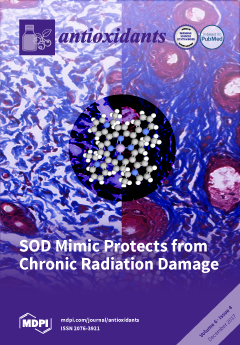The relationship between α-tocopherol, a known antioxidant, and polyunsaturated fatty acid (PUFA) oxidation, has not been directly investigated in the primate brain. This study characterized the membrane distribution of α-tocopherol in brain regions and investigated the association between membrane α-tocopherol and PUFA content,
[...] Read more.
The relationship between α-tocopherol, a known antioxidant, and polyunsaturated fatty acid (PUFA) oxidation, has not been directly investigated in the primate brain. This study characterized the membrane distribution of α-tocopherol in brain regions and investigated the association between membrane α-tocopherol and PUFA content, as well as brain PUFA oxidation products. Nuclear, myelin, mitochondrial, and neuronal membranes were isolated using a density gradient from the prefrontal cortex (PFC), cerebellum (CER), striatum (ST), and hippocampus (HC) of adult rhesus monkeys (
n = 9), fed a stock diet containing vitamin E (α-, γ-tocopherol intake: ~0.7 µmol/kg body weight/day, ~5 µmol/kg body weight/day, respectively). α-tocopherol, PUFAs, and PUFA oxidation products were measured using high performance liquid chromatography (HPLC), gas chromatography (GC) and liquid chromatography-gas chromatography/mass spectrometry (LC-GC/MS) respectively. α-Tocopherol (ng/mg protein) was highest in nuclear membranes (
p < 0.05) for all regions except HC. In PFC and ST, arachidonic acid (AA, µg/mg protein) had a similar membrane distribution to α-tocopherol. Total α-tocopherol concentrations were inversely associated with AA oxidation products (isoprostanes) (
p < 0.05), but not docosahexaenoic acid oxidation products (neuroprostanes). This study reports novel data on α-tocopherol accumulation in primate brain regions and membranes and provides evidence that α-tocopherol and AA are similarly distributed in PFC and ST membranes, which may reflect a protective effect of α-tocopherol against AA oxidation.
Full article






